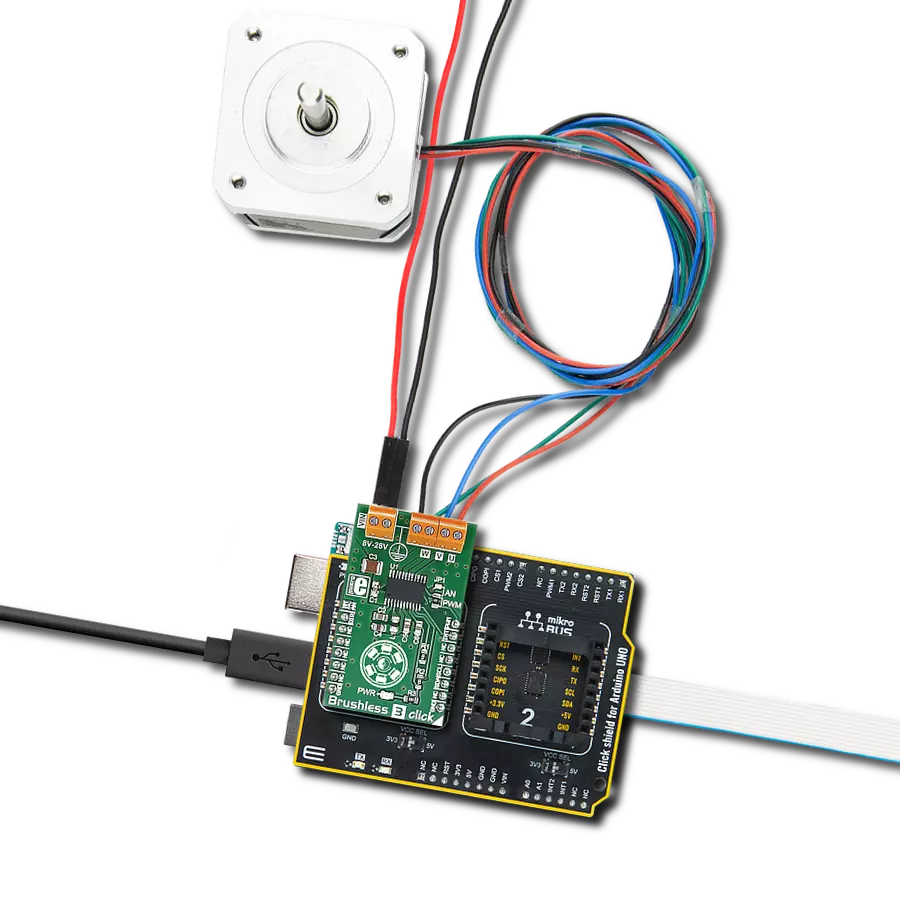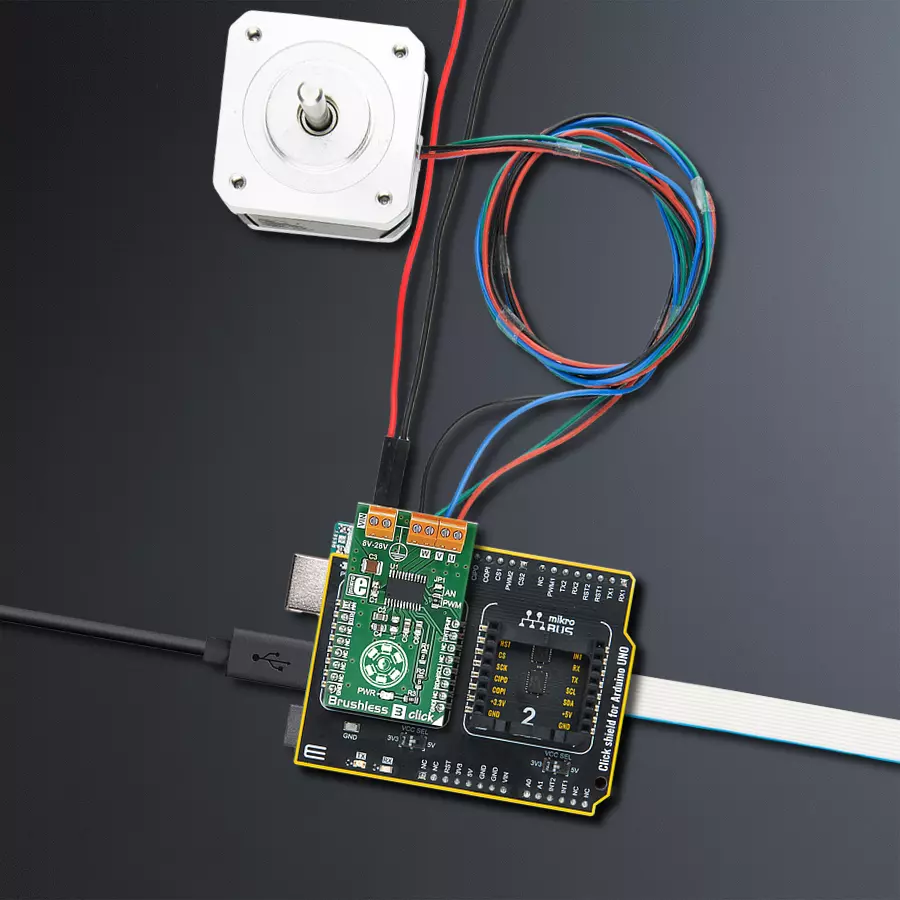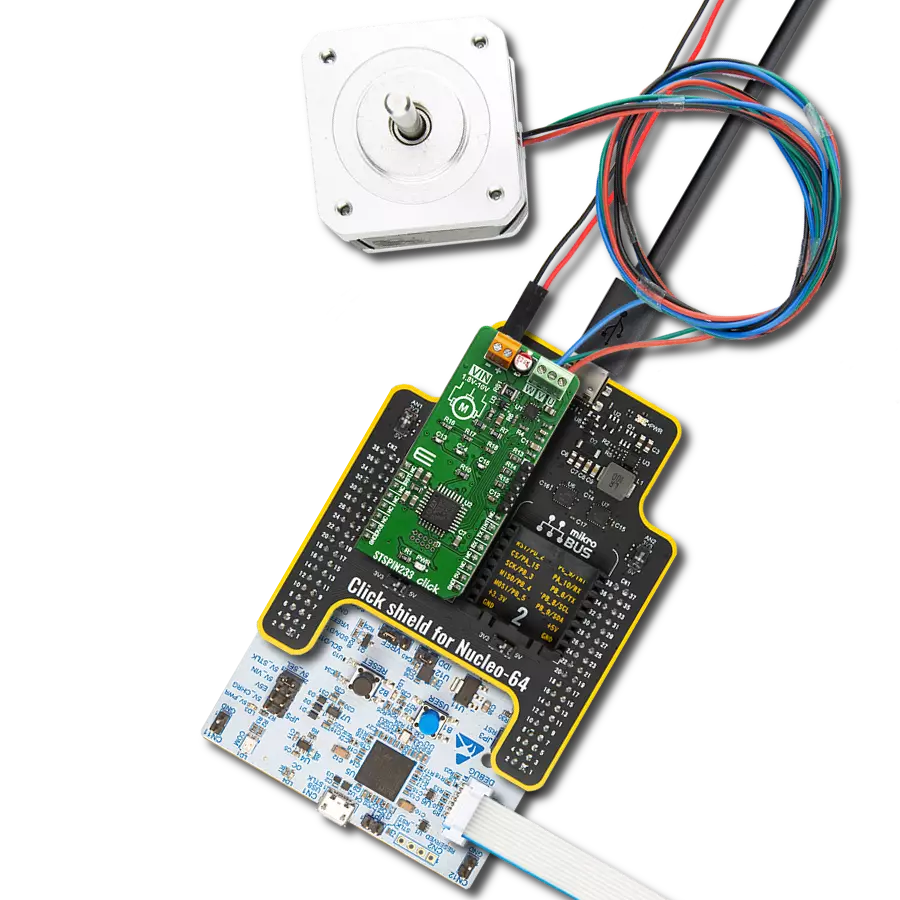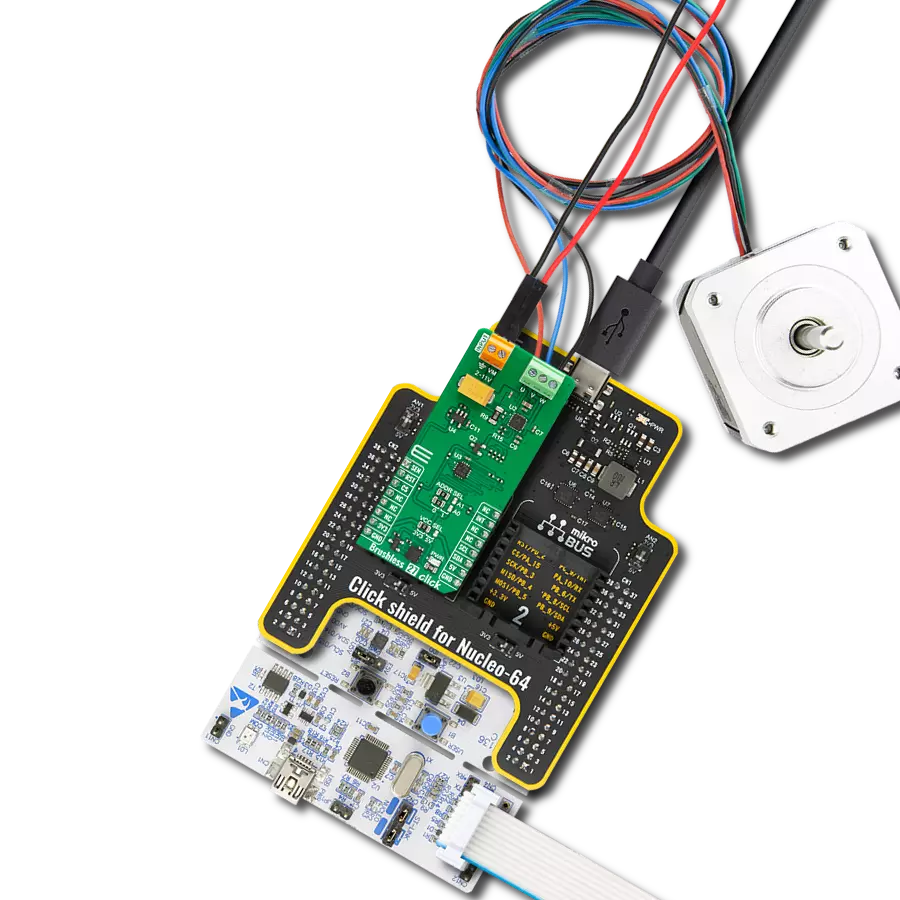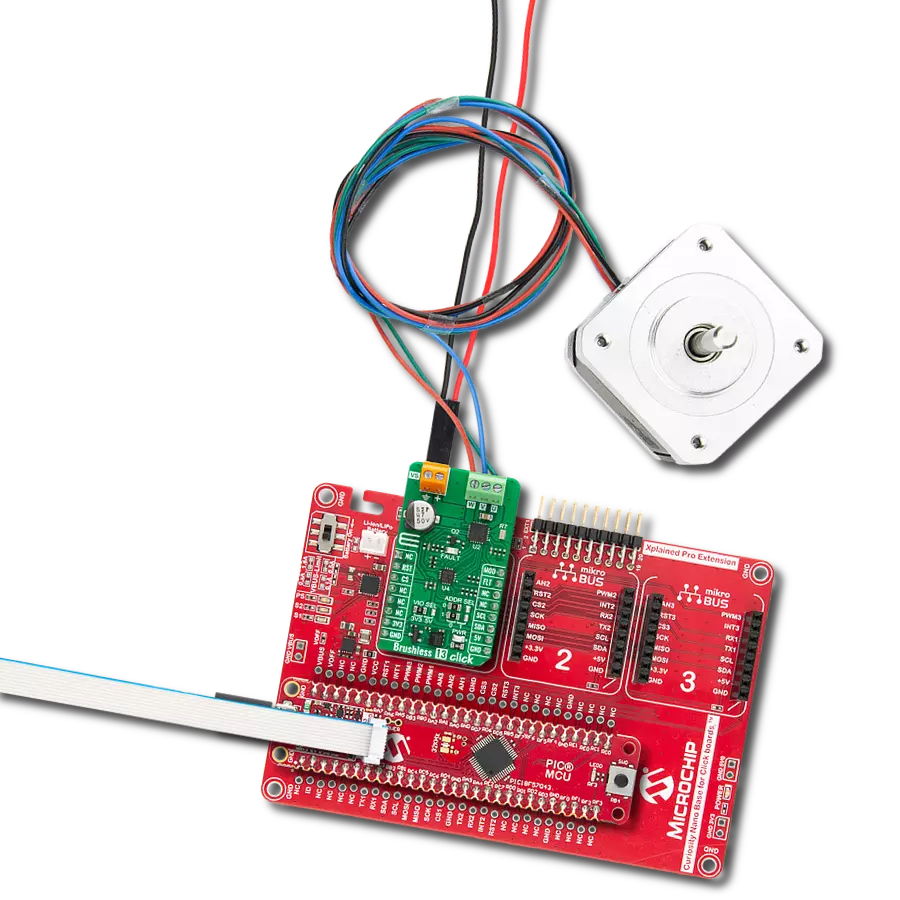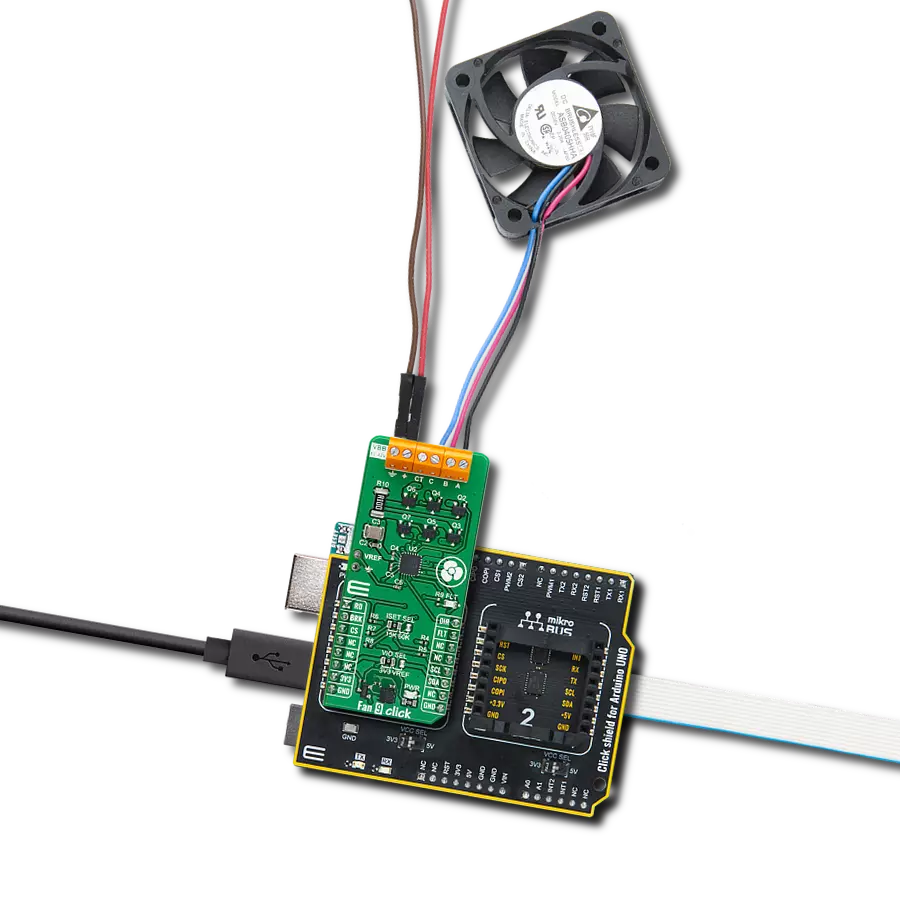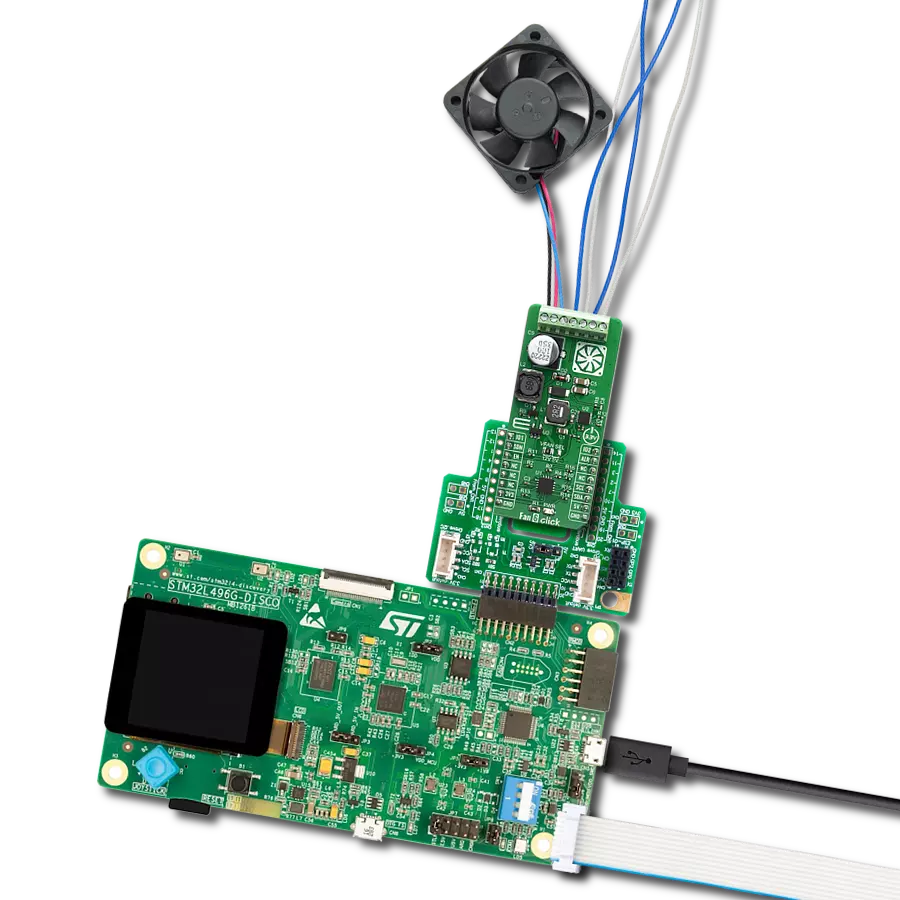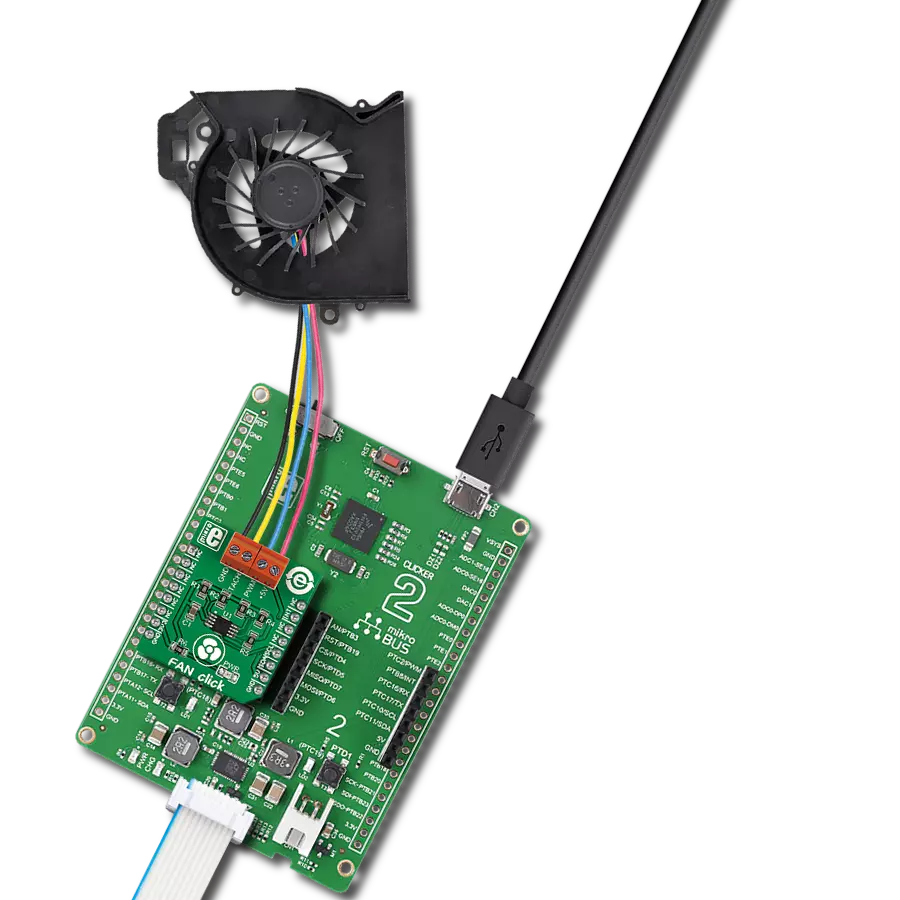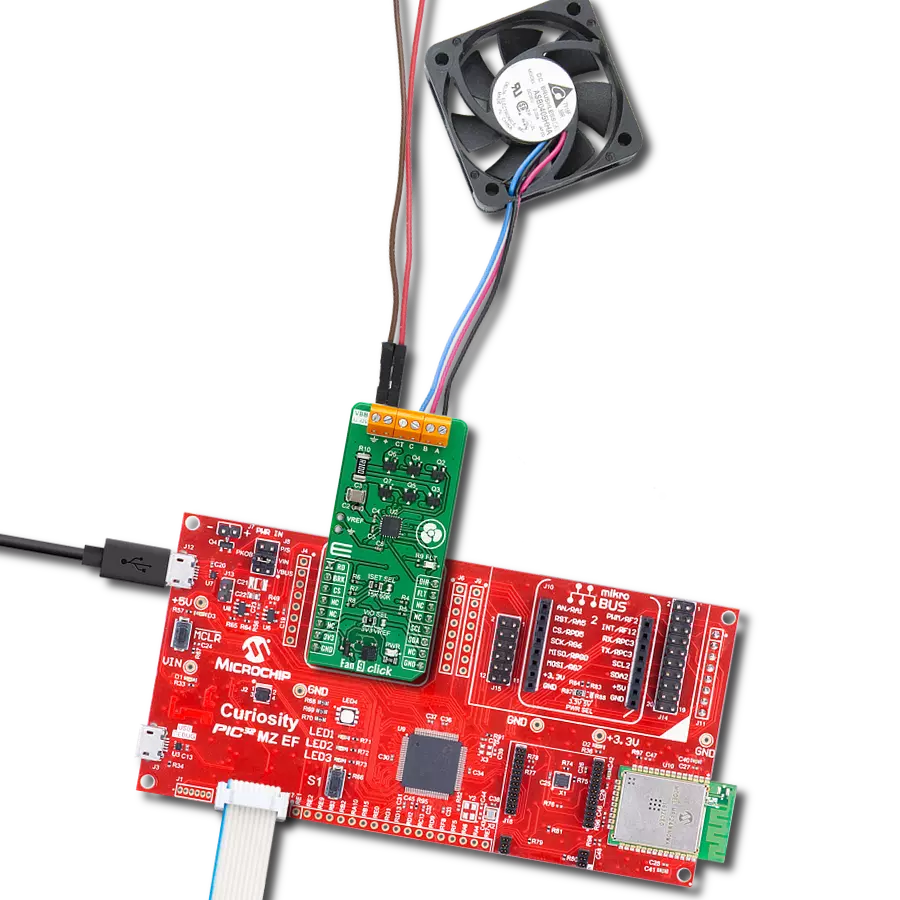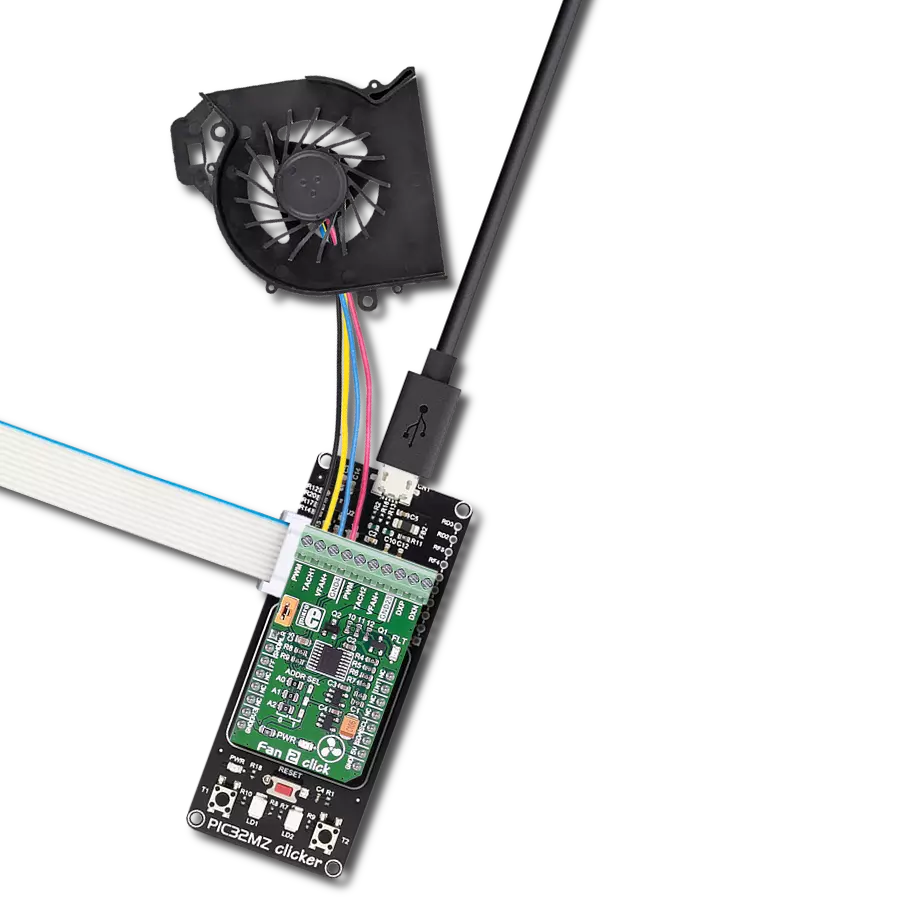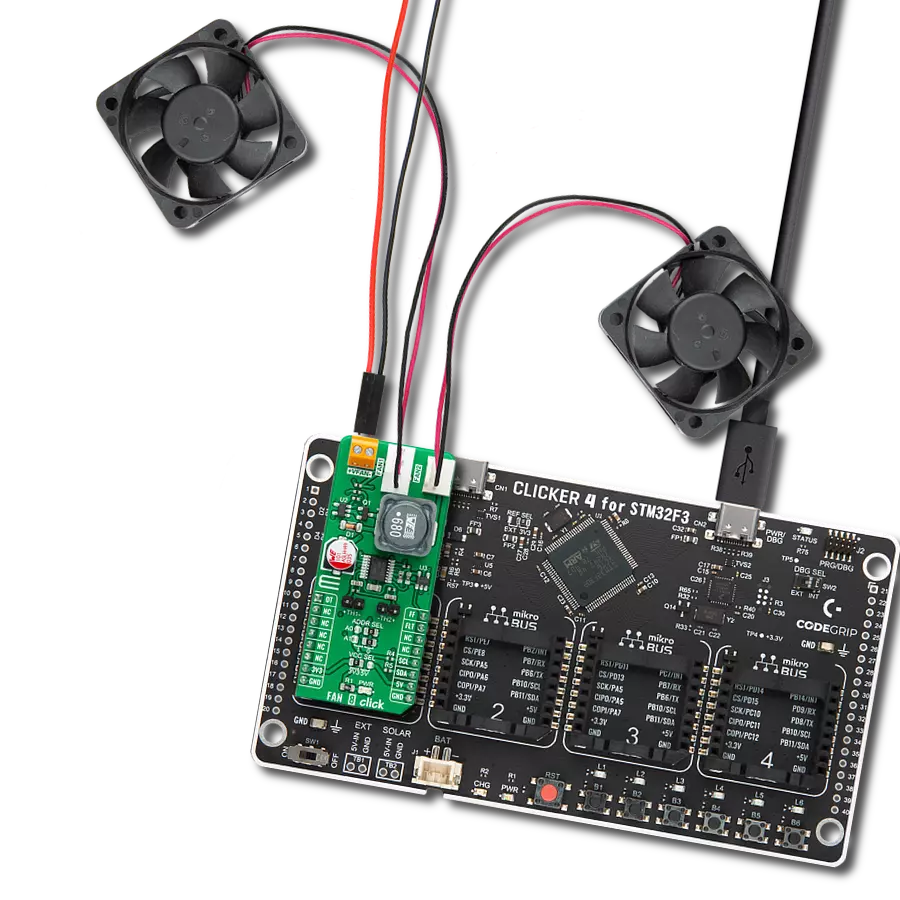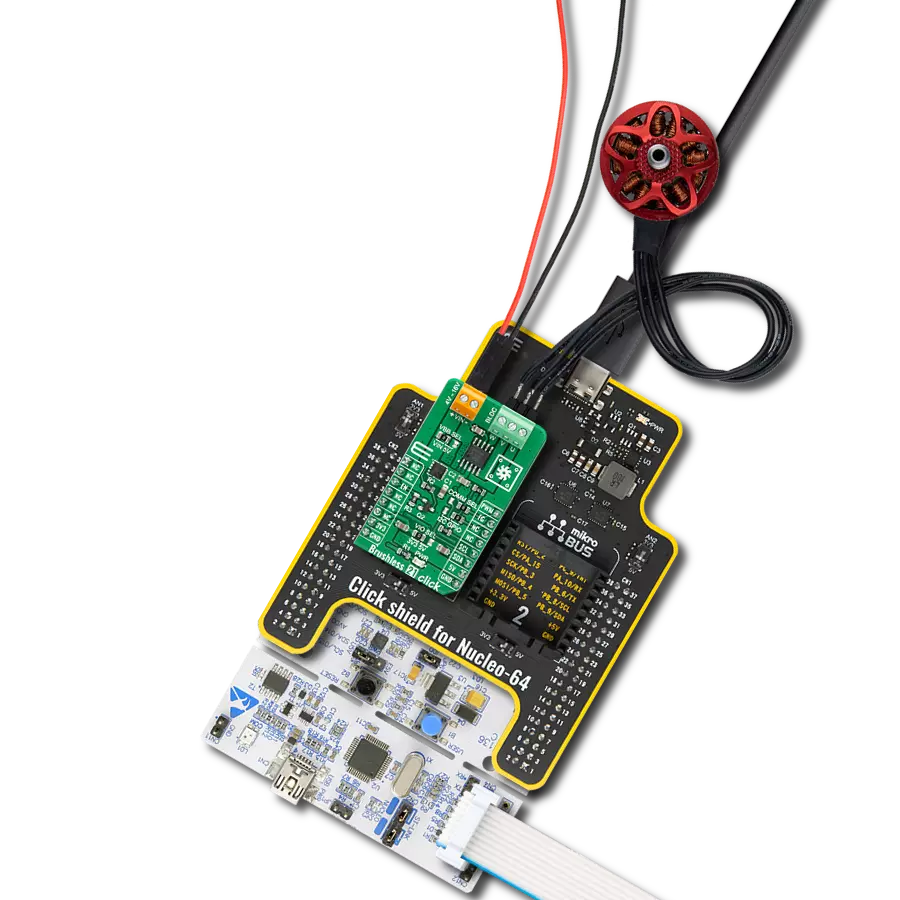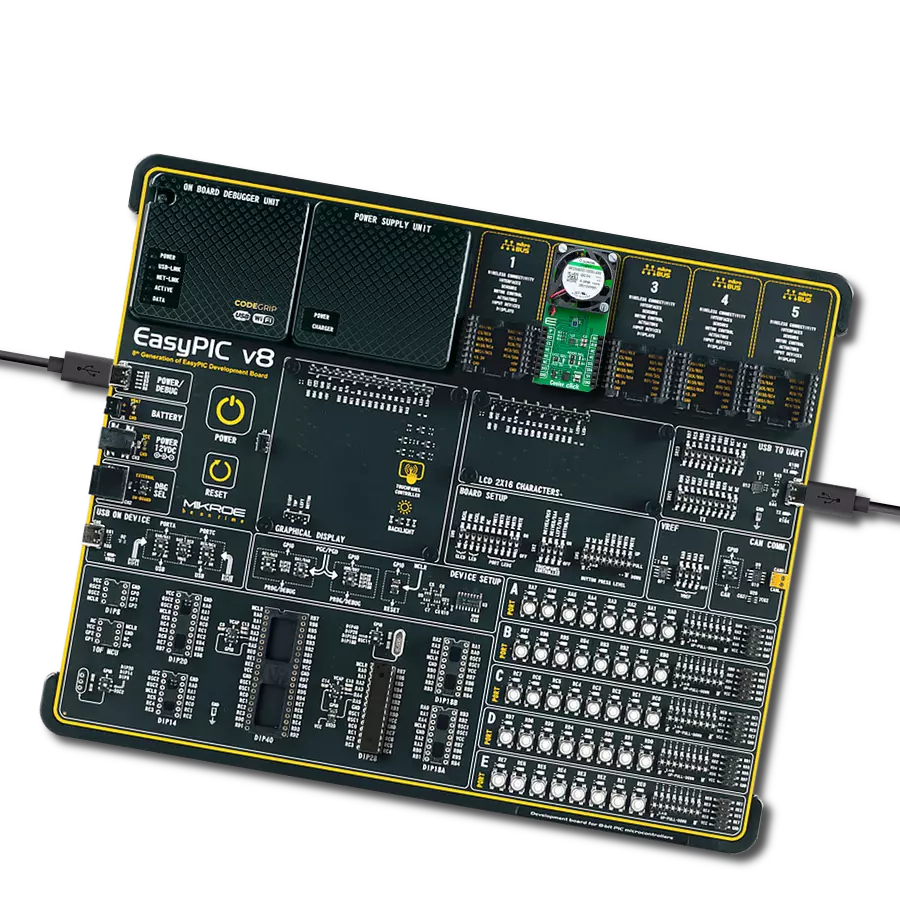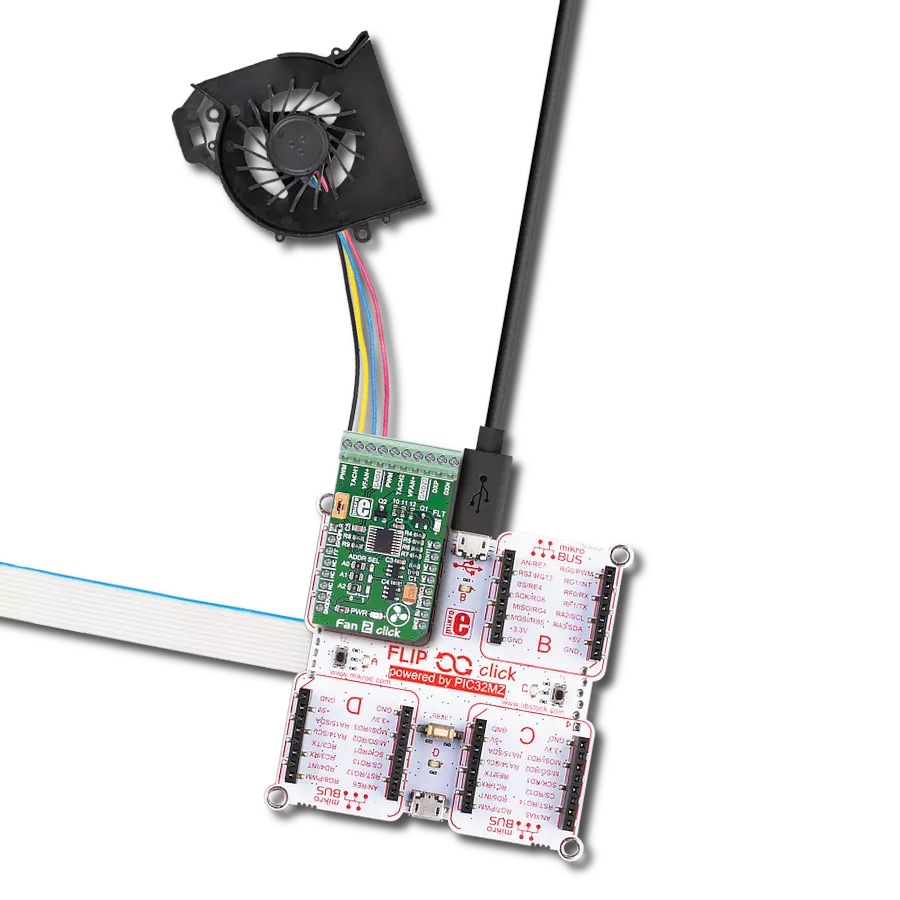Deliver precise speed and torque control, and optimize the performance of brushless motors in various applications
A
A
Hardware Overview
How does it work?
Brushless 3 Click is based on the DRV10983, a three-phase sensorless motor driver with integrated power MOSFETs from Texas Instruments. When an external power supply is applied, you can drive a brushless DC motor through the PWM pin, AN pin, or I2C interface. It communicates with the target microcontroller
over the I2C interface, with the additional functionality provided by the following pins on the mikroBUS™ line: PWM, AN, INT, and RST. The DRV10983 is a three-phase sensorless motor driver with integrated power MOSFETs, which can provide continuous drive current up to 2A. The DRV10983 uses a proprietary sensorless control
scheme to provide continuous sinusoidal drive, significantly reducing the pure tone acoustics that typically occurs due to commutation. The interface to the device is designed to be simple and flexible. The motor can be controlled directly through PWM, analog, or I2C. Motor speed feedback is available through either the FG pin or I2C.
Features overview
Development board
Arduino UNO is a versatile microcontroller board built around the ATmega328P chip. It offers extensive connectivity options for various projects, featuring 14 digital input/output pins, six of which are PWM-capable, along with six analog inputs. Its core components include a 16MHz ceramic resonator, a USB connection, a power jack, an
ICSP header, and a reset button, providing everything necessary to power and program the board. The Uno is ready to go, whether connected to a computer via USB or powered by an AC-to-DC adapter or battery. As the first USB Arduino board, it serves as the benchmark for the Arduino platform, with "Uno" symbolizing its status as the
first in a series. This name choice, meaning "one" in Italian, commemorates the launch of Arduino Software (IDE) 1.0. Initially introduced alongside version 1.0 of the Arduino Software (IDE), the Uno has since become the foundational model for subsequent Arduino releases, embodying the platform's evolution.
Microcontroller Overview
MCU Card / MCU
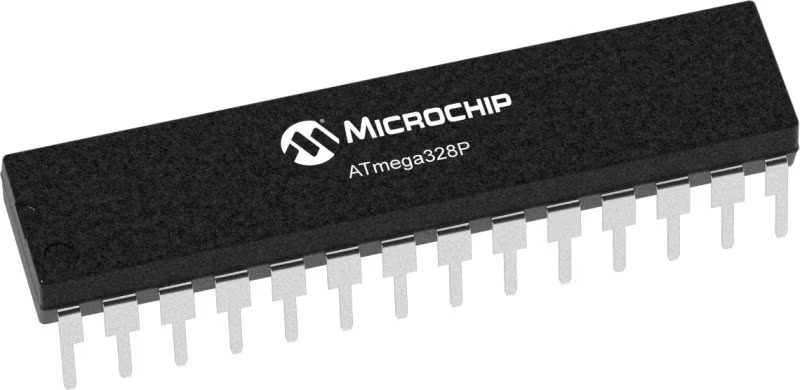
Architecture
AVR
MCU Memory (KB)
32
Silicon Vendor
Microchip
Pin count
28
RAM (Bytes)
2048
You complete me!
Accessories
Click Shield for Arduino UNO has two proprietary mikroBUS™ sockets, allowing all the Click board™ devices to be interfaced with the Arduino UNO board without effort. The Arduino Uno, a microcontroller board based on the ATmega328P, provides an affordable and flexible way for users to try out new concepts and build prototypes with the ATmega328P microcontroller from various combinations of performance, power consumption, and features. The Arduino Uno has 14 digital input/output pins (of which six can be used as PWM outputs), six analog inputs, a 16 MHz ceramic resonator (CSTCE16M0V53-R0), a USB connection, a power jack, an ICSP header, and reset button. Most of the ATmega328P microcontroller pins are brought to the IO pins on the left and right edge of the board, which are then connected to two existing mikroBUS™ sockets. This Click Shield also has several switches that perform functions such as selecting the logic levels of analog signals on mikroBUS™ sockets and selecting logic voltage levels of the mikroBUS™ sockets themselves. Besides, the user is offered the possibility of using any Click board™ with the help of existing bidirectional level-shifting voltage translators, regardless of whether the Click board™ operates at a 3.3V or 5V logic voltage level. Once you connect the Arduino UNO board with our Click Shield for Arduino UNO, you can access hundreds of Click boards™, working with 3.3V or 5V logic voltage levels.
Brushless DC (BLDC) Motor with a Hall sensor represents a high-performance motor from the 42BLF motor series. This motor, wired in a star configuration, boasts a Hall Effect angle of 120°, ensuring precise and reliable performance. With a compact motor length of 47mm and a lightweight design tipping the scales at just 0.29kg, this BLDC motor is engineered to meet your needs. Operating flawlessly at a voltage rating of 24VDC and a speed range of 4000 ± 10% RPM, this motor offers consistent and dependable power. It excels in a normal operational temperature range from -20 to +50°C, maintaining efficiency with a rated current of 1.9A. Also, this product seamlessly integrates with all Brushless Click boards™ and those that require BLDC motors with Hall sensors.
Used MCU Pins
mikroBUS™ mapper
Take a closer look
Click board™ Schematic

Step by step
Project assembly
Software Support
Library Description
This library contains API for Brushless 3 Click driver.
Key functions:
brushless3_set_speed- Set speed functionbrushless3_get_speed- Get speed functionbrushless3_forward_direction- Set the direction of rotation in the forward direction function
Open Source
Code example
The complete application code and a ready-to-use project are available through the NECTO Studio Package Manager for direct installation in the NECTO Studio. The application code can also be found on the MIKROE GitHub account.
/*!
* \file
* \brief Brushless3 Click example
*
* # Description
* This Click has three-phase sensorless motor driver and
* with an external power supply it drives a brushless DC motor.
*
* The demo application is composed of two sections :
*
* ## Application Init
* Initialization driver enable's - I2C, set default parameter value.
*
* ## Application Task
* This is an example which demonstrates the use of Brushless 3 Click board.
* Read and display float motor frequency value from the DRV10983 sensorless
* BLDC motor driver on Brushless 3 Click board. Results are being sent to
* the Usart Terminal where you can track their changes.
*
*
* \author MikroE Team
*
*/
// ------------------------------------------------------------------- INCLUDES
#include "board.h"
#include "log.h"
#include "brushless3.h"
// ------------------------------------------------------------------ VARIABLES
static brushless3_t brushless3;
static log_t logger;
static float velocity = 0;
static int16_t speed = 0;
// ------------------------------------------------------ APPLICATION FUNCTIONS
void application_init ( void )
{
log_cfg_t log_cfg;
brushless3_cfg_t cfg;
/**
* Logger initialization.
* Default baud rate: 115200
* Default log level: LOG_LEVEL_DEBUG
* @note If USB_UART_RX and USB_UART_TX
* are defined as HAL_PIN_NC, you will
* need to define them manually for log to work.
* See @b LOG_MAP_USB_UART macro definition for detailed explanation.
*/
LOG_MAP_USB_UART( log_cfg );
log_init( &logger, &log_cfg );
log_info( &logger, "---- Application Init ----" );
// Click initialization.
brushless3_cfg_setup( &cfg );
BRUSHLESS3_MAP_MIKROBUS( cfg, MIKROBUS_1 );
brushless3_init( &brushless3, &cfg );
if ( BRUSHLESS3_ERROR == brushless3_default_cfg ( &brushless3 ) )
{
log_error( &logger, " Default configuration." );
for ( ; ; );
}
}
void application_task ( void )
{
log_printf( &logger, " acceleration \r\n" );
for ( speed = 100; speed <= BRUSHLESS3_MAX_SPEED; speed += 20 )
{
brushless3_set_speed( &brushless3, speed );
brushless3_get_speed( &brushless3, &velocity );
log_printf( &logger, " Motor frequency: %.2f Hz\r\n", velocity );
Delay_ms ( 100 );
}
log_printf( &logger, "\r\n ---------------------- \r\n" );
log_printf( &logger, " slowing down \r\n" );
for ( speed = BRUSHLESS3_MAX_SPEED; speed >= 50; speed -= 20 )
{
brushless3_set_speed( &brushless3, speed );
brushless3_get_speed( &brushless3, &velocity );
log_printf( &logger, " Motor frequency: %.2f Hz\r\n", velocity );
Delay_ms ( 100 );
}
log_printf( &logger, "-----------------------\r\n" );
Delay_ms ( 1000 );
}
int main ( void )
{
/* Do not remove this line or clock might not be set correctly. */
#ifdef PREINIT_SUPPORTED
preinit();
#endif
application_init( );
for ( ; ; )
{
application_task( );
}
return 0;
}
// ------------------------------------------------------------------------ END
Additional Support
Resources
Category:Brushless
